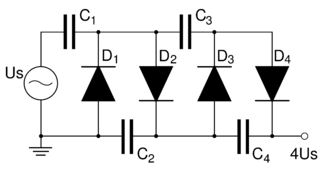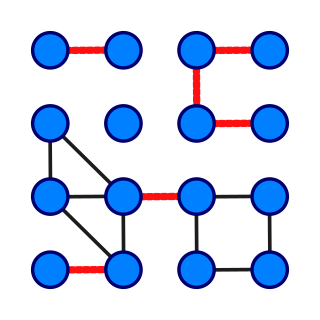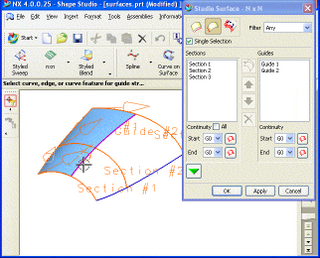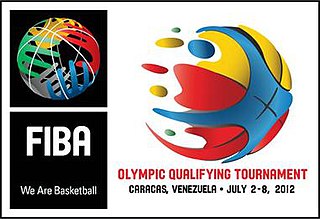Related Research Articles

A circle is a shape consisting of all points in a plane that are at a given distance from a given point, the centre. The distance between any point of the circle and the centre is called the radius.

A multivibrator is an electronic circuit used to implement a variety of simple two-state devices such as relaxation oscillators, timers, latches and flip-flops. The first multivibrator circuit, the astable multivibrator oscillator, was invented by Henri Abraham and Eugene Bloch during World War I. It consisted of two vacuum tube amplifiers cross-coupled by a resistor-capacitor network. They called their circuit a "multivibrator" because its output waveform was rich in harmonics. A variety of active devices can be used to implement multivibrators that produce similar harmonic-rich wave forms; these include transistors, neon lamps, tunnel diodes and others. Although cross-coupled devices are a common form, single-element multivibrator oscillators are also common.

In group theory, the symmetry group of a geometric object is the group of all transformations under which the object is invariant, endowed with the group operation of composition. Such a transformation is an invertible mapping of the ambient space which takes the object to itself, and which preserves all the relevant structure of the object. A frequent notation for the symmetry group of an object X is G = Sym(X).

In the mathematical field of differential geometry, the Gauss–Bonnet theorem is a fundamental formula which links the curvature of a surface to its underlying topology.
In geometry, the kissing number of a mathematical space is defined as the greatest number of non-overlapping unit spheres that can be arranged in that space such that they each touch a common unit sphere. For a given sphere packing in a given space, a kissing number can also be defined for each individual sphere as the number of spheres it touches. For a lattice packing the kissing number is the same for every sphere, but for an arbitrary sphere packing the kissing number may vary from one sphere to another.

A voltage multiplier is an electrical circuit that converts AC electrical power from a lower voltage to a higher DC voltage, typically using a network of capacitors and diodes.

In mathematics, an Apollonian gasket or Apollonian net is a fractal generated by starting with a triple of circles, each tangent to the other two, and successively filling in more circles, each tangent to another three. It is named after Greek mathematician Apollonius of Perga.
In mathematics, and in particular in combinatorics, the combinatorial number system of degree k, also referred to as combinadics, or the Macaulay representation of an integer, is a correspondence between natural numbers N and k-combinations. The combinations are represented as strictly decreasing sequences ck > ... > c2 > c1 ≥ 0 where each ci corresponds to the index of a chosen element in a given k-combination. Distinct numbers correspond to distinct k-combinations, and produce them in lexicographic order. The numbers less than correspond to all k-combinations of {0, 1, ..., n − 1}. The correspondence does not depend on the size n of the set that the k-combinations are taken from, so it can be interpreted as a map from N to the k-combinations taken from N; in this view the correspondence is a bijection.

In graph theory, a bridge, isthmus, cut-edge, or cut arc is an edge of a graph whose deletion increases the graph's number of connected components. Equivalently, an edge is a bridge if and only if it is not contained in any cycle. For a connected graph, a bridge can uniquely determine a cut. A graph is said to be bridgeless or isthmus-free if it contains no bridges.

The Cockcroft–Walton (CW) generator, or multiplier, is an electric circuit that generates a high DC voltage from a low-voltage AC. It was named after the British and Irish physicists John Douglas Cockcroft and Ernest Thomas Sinton Walton, who in 1932 used this circuit design to power their particle accelerator, performing the first artificial nuclear disintegration in history. They used this voltage multiplier cascade for most of their research, which in 1951 won them the Nobel Prize in Physics for "Transmutation of atomic nuclei by artificially accelerated atomic particles".

Freeform surface modelling is a technique for engineering freeform surfaces with a CAD or CAID system.

In geometry, a two-dimensional point group or rosette group is a group of geometric symmetries (isometries) that keep at least one point fixed in a plane. Every such group is a subgroup of the orthogonal group O(2), including O(2) itself. Its elements are rotations and reflections, and every such group containing only rotations is a subgroup of the special orthogonal group SO(2), including SO(2) itself. That group is isomorphic to R/Z and the first unitary group, U(1), a group also known as the circle group.

In hyperbolic geometry, a hypercycle, hypercircle or equidistant curve is a curve whose points have the same orthogonal distance from a given straight line.

Catene is a double studio album by Italian singer Mina, released in October 1983 by PDU and distributed by EMI Italiana.

The FIBA World Olympic Qualifying Tournament for Men 2008 was the final qualifying tournament for the 2008 Olympic men's basketball tournament. Organized by FIBA, it took place from 14 to 20 July 2008 at the OAKA Indoor Sports Arena, in Athens, Greece. The draw for the tournament was held on 31 January 2008 at the Divani Caravel hotel in Athens.

Kyrie is a double studio album by Italian singer Mina released on 27 November 1980 by PDU and distributed by EMI Italiana. Later the album was released in separate parts with subtitles "Vol. 1" and "Vol. 2". On this album Mina experiments with various genres, especially rock. The cover of the album features Mina's son Massimiliano Pani dressed as a hockey player.

The Kawasaki KR-1 and KR-1S are road-orientated 249 cc (15.2 cu in) two-stroke sports bikes introduced between 1988 and 1992 by Kawasaki Heavy Industries.

The 2012 FIBA World Olympic Qualifying Tournament was a men's basketball tournament that consisted of 12 national teams, where the top three teams earned a place in the 2012 Olympics basketball tournament. It was held on 2–8 July 2012 in Caracas, Venezuela.

In statistics and data analysis, the application software SegReg is a free and user-friendly tool for linear segmented regression analysis to determine the breakpoint where the relation between the dependent variable and the independent variable changes abruptly.

Italiana is a double studio album by Italian singer Mina, released in November 1982 by PDU and distributed by EMI Italiana.
References
- 1 2 Hill, T. P. (1983). "Determining a Fair Border". The American Mathematical Monthly. 90 (7): 438–442. doi:10.2307/2975720. JSTOR 2975720.
- 1 2 Beck, A. (1987). "Constructing a Fair Border". The American Mathematical Monthly. 94 (2): 157–162. doi:10.2307/2322417. JSTOR 2322417.
- For an additional solution to the problem, see: Webb, W. A. (1990). "A Combinatorial Algorithm to Establish a Fair Border". European Journal of Combinatorics. 11 (3): 301–304. doi:10.1016/s0195-6698(13)80129-1.